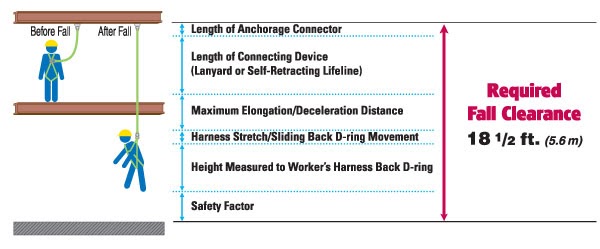Personal Fall Arresting Systems
Components of a personal fall arresting system include a body harness, lanyard, lifeline, connector, and an anchorage point capable of supporting at least 5000 pounds.
- Full body harnesses must be used at all times for Fall Arrest Systems.
- Limit maximum arresting force on a worker to 1,800 lbs. when using a body harness.
- Fall arrest system must be rigged so a worker can neither free fall more than 6 feet (4 in CA), nor contact any lower level. Deceleration devices used must not exceed 3.5 feet. The image below illustrates how to calculate free fall distance when using fall protection.

Calculating Fall Clearances
Image Source: http://safetyequipmentfaq.com/2014/01/19/shock-absorbing-lanyard-limitations/
- D-rings and snap hooks must have a minimum tensile strength of 5,000 lbs.
- Full-body harnesses come with optional side, front and shoulder D-rings. The side and front D-rings are connection points used for work positioning, and the shoulder D-rings are for retrieval from confined spaces.
- Snap hooks must be sized to be compatible with the member to which they are connected to for the prevention of rollout. Only locking-type snap hooks must be used.
- Horizontal lifelines must be designed, installed, and used under the supervision of a qualified person as part of a complete personal fall arrest system maintaining a safety factor of at least two.
- Lanyards and vertical lifelines must have a minimum breaking strength of 5,000 lbs.
- Lifelines must be protected against being cut or abraded.

